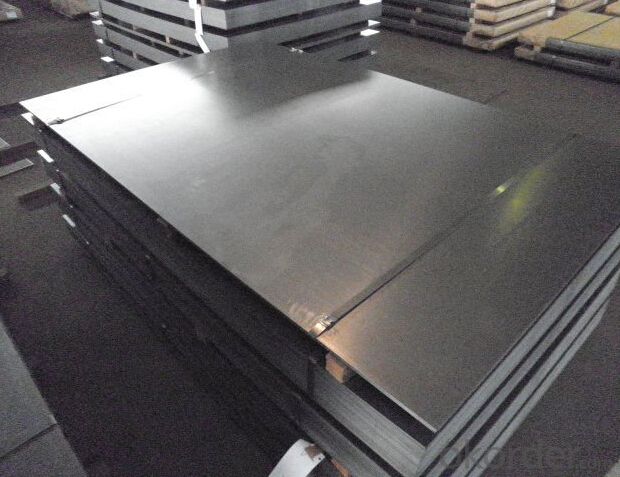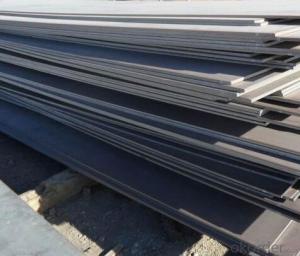Steel Plate/Sheet AISI/ASTM A36 Hot Rolled/Cold Rolled
- Loading Port:
- Tianjin
- Payment Terms:
- TT OR LC
- Min Order Qty:
- 50 m.t.
- Supply Capability:
- 50000 m.t./month
OKorder Service Pledge
OKorder Financial Service
You Might Also Like
Item specifice
1.Description of steel plate:
Our products into high-strength low-alloy steel plate, carbon structural steel plate, alloy structural steel plate, boiler and pressure vessel steel plate, bridge steel plate, structural steel plate, shipbuilding steel plate and marine oil platform steel plate, pipe steel plate, high strength and high toughness steel plate, mold plate, corrosion-resistant plate, Wear-resistand steel plate, composite plate with 12 major series.
2.Size range: Steel Plate width 300-5000mm, thickness 5-600mm, length 1000-18000mm.
Usage: (1).used for metallurgical, mechanical, electrical construction field
(2).used for ships, military (armored) Construction
(3).used for outside engineering, machine tool base, automobile rear of products
3.Standard: According to user requirements, can be delivered the following criteria: National standards, the metallurgical industry, the American ASTM, ASME standards, Japanese JIS, German DIN, British BS, European EN, the international ISO standards and the standards specific board.
4.Inspection Standard: In accordance with China (JB4730, GB/T2970), United States (A435, A577, A588), Japan (JISG0801, JISG0901), Germany (SEL072), British (BS5996), France (NFS04-305) and other domestic and international testing standard production test.
5.Data of steel sheet:
Name | Hot rolled Carbon steel plate sheet (Q235, Q345, SS400, A36, S235JR, S355JR, S45C, S50C, A572, ST37, ST37-2,ST52) |
Specification | Width: 900-2500mm or 1000,1050,1250,1500,1800,2000mm |
Thickness:1.5mm-200mm | |
or as customers’ special requirements; | |
Length | Length 2-12m or as customers’ special requirements; |
Grade of hot rolled steel plate sheet | SS400, ASTM A36, A572, ST37,ST52, Q195, Q215, Q235,Q345, S235JR, S355JR, S45C, S50C |
Standards | GB/T709-2006, ASTM A36, JIS G3101, DIN EN 10025, SAE 1045, ASTM A570 |
Surface | Smooth, straight, bright, no blur on both ends |
Packaging | Standard exporting packing or as client's requirement |
Certificate | ISO9001:2008 |
Processing technique |
|
Feature of hot rolled steel plate sheet |
|
Excellent performances hot-rolled steel products |
|
6.Image of steel sheet:

7.FAQ
We have organized several common questions for our clients,may help you sincerely:
①How about your Warranty?
Warranty: 1-Year for the whole light. Warranty is based on correct storage, installation, using and maintenanc
②How to guarantee the quality of the products?
We have established the international advanced quality management system,every link from raw material to final product we have strict quality test;We resolutely put an end to unqualified products flowing into the market. At the same time, we will provide necessary follow-up service assurance.
③How long can we receive the product after purchase?
In the purchase of product within three working days, We will arrange the factory delivery as soon as possible. The pecific time of receiving is related to the state and position of customers.Commonly 7 to 10 working days can be served.
- Q:How do steel sheets perform in terms of scratch resistance?
- Steel sheets generally have good scratch resistance due to their strong and durable nature. They are less susceptible to scratching compared to other materials, making them suitable for various applications where scratching is a concern. However, the scratch resistance may vary depending on the specific type and finish of the steel sheet.
- Q:Do steel sheets require any special storage or handling?
- Special storage and handling are required for steel sheets. To prevent corrosion and damage, it is crucial to store them in a dry and well-ventilated area, avoiding moisture buildup. Additionally, they should be kept away from direct sunlight and extreme temperature fluctuations to prevent warping or cracking. To prevent bending or sagging, steel sheets should be stored horizontally on a flat surface. Furthermore, it is advisable to stack them securely and appropriately, utilizing suitable supports or pallets, to prevent accidents or injuries. When handling steel sheets, proper lifting equipment and techniques should be employed to avoid injuries and sheet damage. Wearing gloves is essential to protect against sharp edges, and caution should be exercised to prevent contact with materials that may cause scratches or damage. Adhering to these storage and handling guidelines will ensure the durability and quality of steel sheets.
- Q:What is the typical impact resistance of a steel sheet?
- The typical impact resistance of a steel sheet can vary depending on factors such as the grade of steel, thickness, and any additional treatments or coatings applied. However, steel sheets generally have good impact resistance due to the inherent strength and toughness of the material.
- Q:How are steel sheets protected during storage and handling?
- Steel sheets are protected during storage and handling through various methods to prevent damage and ensure their quality. One of the most common ways to protect steel sheets is by using a protective coating or oil. This coating acts as a barrier against moisture and other environmental factors that can cause corrosion or rust. Steel sheets are often stored in covered warehouses or storage areas to shield them from direct sunlight, rain, and other weather elements. This helps to prevent any potential damage to the sheets and maintain their integrity. During transportation and handling, steel sheets are typically lifted using cranes or forklifts with appropriate lifting equipment to avoid any bending or twisting. They are also properly secured and stacked in a way that minimizes the risk of damage or deformation. In addition, steel sheets are often packaged using materials such as plastic or cardboard to provide further protection against scratches or other physical damage. They may also be wrapped or sealed to prevent any contact with moisture or other contaminants. Overall, the goal is to ensure that steel sheets are kept in a safe and controlled environment during storage and handling to maintain their quality and prevent any potential damage that could compromise their performance in future applications.
- Q:Are the steel sheets easy to transport and handle?
- Steel sheets are quite convenient to transport and handle. They are generally lightweight and can be effortlessly piled and loaded onto trucks or containers for transportation. Moreover, steel sheets frequently come in standardized sizes and shapes, which simplifies their manipulation and maneuverability. Nevertheless, it is crucial to acknowledge that the size and thickness of the steel sheets can affect their ease of transportation and handling. Bigger and thicker sheets may necessitate specialized equipment or extra manpower to lift and relocate them.
- Q:What is a fixed length steel plate?
- Such as steel plate, its fixed length is six meters, then it is 6 meters, the size will not be uneven. The standard size of the general steel plate is determined according to the national standard, such as 6 meters, 9 meters, etc..
- Q:How are steel sheets packaged for shipping?
- Steel sheets are typically packaged for shipping by being stacked on wooden pallets and secured with steel or plastic strapping. Additionally, they may be further protected by being wrapped in plastic or covered with a cardboard or wooden crate for added stability and protection during transportation.
- Q:What is the difference between coated and uncoated steel sheets?
- The primary distinction between coated and uncoated steel sheets lies in their protective layer and surface finish. Coated steel sheets, also referred to as galvanized steel sheets, possess a layer of zinc coating to prevent corrosion and enhance durability. This zinc coating serves as a sacrificial layer, shielding the underlying steel from rust and other forms of damage. Furthermore, coated steel sheets exhibit a more polished and smoother appearance. In contrast, uncoated steel sheets do not undergo any treatment involving a protective layer. Consequently, they are more prone to corrosion, particularly when exposed to moisture or chemicals. Uncoated steel sheets are commonly utilized in situations where corrosion resistance is not a significant concern, such as in construction projects where the steel will be covered or safeguarded in some manner. Regarding cost, coated steel sheets are generally pricier than uncoated steel sheets due to the additional manufacturing process required to apply the zinc coating. Nevertheless, the increased cost is justified by the improved durability and extended lifespan of coated steel sheets. To summarize, the key disparity between coated and uncoated steel sheets lies in the presence of a protective layer. Coated steel sheets offer superior corrosion resistance and possess a smoother appearance, while uncoated steel sheets are more susceptible to corrosion and possess a rougher surface finish.
- Q:What are the different types of surface patterns available for steel sheets?
- Steel sheets come in a variety of surface patterns, each with its own unique properties and appearances. Here are some of the most common patterns: 1. Smooth: Smooth steel sheets have a flat and even surface, without any visible patterns or textures. They are used when functionality is more important than aesthetics. 2. Diamond: Diamond pattern steel sheets have a raised diamond-shaped pattern, providing excellent slip resistance. They are suitable for areas where grip is important, such as flooring and stairs. 3. Checkered: Checkered steel sheets have a grid-like pattern with raised and recessed squares or rectangles. This pattern enhances slip resistance and is commonly used in industrial and transportation applications. 4. Embossed: Embossed steel sheets have a textured pattern pressed or rolled onto the surface. They can have designs like wood grain or geometric shapes, and are used in interior and architectural applications for their decorative and tactile qualities. 5. Perforated: Perforated steel sheets have evenly spaced holes or perforations, allowing for air, light, and sound to pass through. They are used in industries such as filtration and ventilation. 6. Brushed: Brushed steel sheets have a satin-like finish achieved by mechanically polishing the surface in one direction. This creates a sleek and modern appearance, commonly seen in architectural and decorative applications. 7. Rustic: Rustic steel sheets have a weathered or aged appearance, resembling rusted or patinated metal. This aesthetic is achieved through chemical treatments or specialized coatings, and is popular in architectural and interior design. These are just a few examples of the different surface patterns available for steel sheets. The choice of pattern depends on the desired functionality, aesthetics, and specific requirements of the application.
- Q:What factors affect the cost of steel sheets?
- Several factors affect the cost of steel sheets, including the current market demand and supply, raw material prices, manufacturing and processing costs, transportation and logistics expenses, as well as any applicable trade tariffs or taxes. Additionally, factors such as the type and quality of steel, size and thickness of the sheets, as well as any special finishes or coatings required, can also impact the overall cost.
1. Manufacturer Overview |
|
|---|---|
| Location | |
| Year Established | |
| Annual Output Value | |
| Main Markets | |
| Company Certifications | |
2. Manufacturer Certificates |
|
|---|---|
| a) Certification Name | |
| Range | |
| Reference | |
| Validity Period | |
3. Manufacturer Capability |
|
|---|---|
| a)Trade Capacity | |
| Nearest Port | |
| Export Percentage | |
| No.of Employees in Trade Department | |
| Language Spoken: | |
| b)Factory Information | |
| Factory Size: | |
| No. of Production Lines | |
| Contract Manufacturing | |
| Product Price Range | |
Send your message to us
Steel Plate/Sheet AISI/ASTM A36 Hot Rolled/Cold Rolled
- Loading Port:
- Tianjin
- Payment Terms:
- TT OR LC
- Min Order Qty:
- 50 m.t.
- Supply Capability:
- 50000 m.t./month
OKorder Service Pledge
OKorder Financial Service
Similar products
New products
Hot products
Related keywords





























